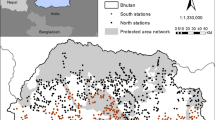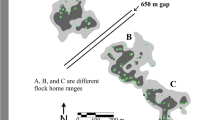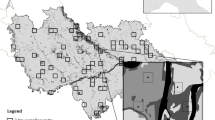Abstract
In this study we used a multi-spatial scale approach to investigate habitat suitability, roosting characteristics, and ecological niche in two flying fox species on the Comoros Islands—Pteropus livingstonii and Pteropus seychellensis comorensis. At a broad scale, we assessed the ecological niche and habitat suitability for both species using the Species Distribution Modeling method based on the recent ensembles of small models (ESM) approach. At a fine scale, Ecological Niche Factor Analysis (ENFA) was applied to assess habitat selection by each species. Direct observation was used at each roost to estimate the total number of individuals and to identify the roost characteristics. At both broad and fine scales, the analyses highlighted clear niche partitioning by the two species. We found that P. livingstonii has a very limited distribution, restricted to steep, high-elevation slopes of the islands’ remaining natural forests, and the patterns were the same for roosting, foraging sites and the entire habitat. By contrast, P. s. comorensis has a relatively large geographic range that extends over low-elevation farmlands and villages and it was negatively correlated to natural forest across the entire area and all roosting sites, but its foraging areas were positively correlated to natural forest and high elevation areas. Both species selected large, tall trees for roosting. The total number of individuals in the studied area was estimated to be 1243 P. livingstonii and 11,898 P. s. comorensis. The results of our study demonstrated that these two species use different habitat types and ensure different ecosystem services in pollination and seed dispersion and thus are both critical for maintaining overall ecosystem dynamics. However, the currently high level of hunting pressure and roost disturbance makes them vulnerable to extinction. To ensure the viability of both species, conservation measures need to be taken by the Comoros government.









Similar content being viewed by others
References
Abedi-lartey M, Dechmann DKN, Wikelski M et al (2016) Long-distance seed dispersal by straw-coloured fruit bats varies by season and landscape. Glob Ecol Conserv 7:12–24. https://doi.org/10.1016/j.gecco.2016.03.005
Ancillotto L, Cistrone L, Mosconi F et al (2014) The importance of non-forest landscapes for the conservation of forest bats: lessons from barbastelles (Barbastella barbastellus). Biodivers Conserv 24:171–185. https://doi.org/10.1007/s10531-014-0802-7
Aziz SA, Olival KJ, Bumrungsri S, Richards GC (2016) The conflict between Pteropodid bats and fruit growers: species, legislation and mitigation. In: Voigt CC, Kingston T (eds) Bats in the anthropocene: conservation of bats in a changing world. Springer, Berlin, pp 277–426
Aziz SA, Clements GR, McConkey KR et al (2017) Pollination by the locally endangered island flying fox (Pteropus hypomelanus) enhances fruit production of the economically important durian (Durio zibethinus). Ecol Evol 7:8670–8684. https://doi.org/10.1002/ece3.3213
Barbet-Massin M, Jiguet F, Albert CH, Thuiller W (2012) Selecting pseudo-absences for species distribution models: how, where and how many? Methods Ecol Evol 3:327–338. https://doi.org/10.1111/j.2041-210X.2011.00172.x
Basile M, Calenge C, Andersen R, Gaillard J-M (2008) Assessing habitat selection using multivariate statistics: some refinements of the ecological-niche factor analysis. Ecol Model 211:233–240. https://doi.org/10.1016/j.ecolmodel.2007.09.006
Breiner FT, Guisan A, Bergamini A, Nobis MP (2015) Overcoming limitations of modelling rare species by using ensembles of small models. Methods Ecol Evol 6:1210–1218. https://doi.org/10.1111/2041-210X.12403
Broennimann O, Petitpierre B, Randin C et al (2015) Ecospat: spatial ecology miscellaneous methods. R Packag Version 1:1
Boussougou GB, Brou, YT, Mohamed I (2015) Changements de la couverture forestière dans l’île d’Anjouan entre 1995 et 2014. ‘Sageo’ 2015. pp 1–14
Calenge C (2006) The package “adehabitat” for the R software: a tool for the analysis of space and habitat use by animals. Ecol Model 197:516–519
Carroll JB, Thorpe IC (1991) The conservation of Livingstone’s fruit bat Pteropus livingstonii Gray 1866: a report on an expedition to the Comores in 1990. Dodo, J Jersey Wildl Preserv Trust 27:26–40
Cheke AS (2011) Was the flying-fox Pteropus comorensis on Mafia Island (Tanzania) introduced by humans? J East Afr Nat Hist 100:59–68
Crawford PHC, Hoagland BW (2010) Using species distribution models to guide conservation at the state level: the endangered American burying beetle (Nicrophorus americanus) in Oklahoma. Insect Conserv 1989:511–521. https://doi.org/10.1007/s10841-010-9280-8
Daniel BM, Green KE, Doulton H et al (2016) A bat on the brink? A range-wide survey of the critically endangered Livingstone’s fruit bat Pteropus livingstonii. Oryx 51:742–751. https://doi.org/10.1017/S0030605316000521
Dray S, Dufour AB (2007) The ade4 package: implementing the duality diagram for ecologists. J Stat Softw 22(4):1–20
Elith J, Graham CH, Anderson R et al (2006) Novel methods improve prediction of species’ distributions from occurrence data. Ecography (Cop) 29:129–151. https://doi.org/10.1111/j.2006.0906-7590.04596.x
FAO (2010) Évaluation des ressources forestières mondiales 2010. Rapport national: Comores. Report #FRA2010/044. Food and Agriculture Organization of the United Nations, Rome, Italy
Friday ET, James O, Olusegun O, Gabriel A (2011) Investigations on the nutritional and medicinal potentials of Ceiba pentandra leaf: a common vegetable in Nigeria. Int J Plant Physiol Biochem 3:95–101
Giannini TC, Acosta AL, Garófalo CA et al (2012) Pollination services at risk: bee habitats will decrease owing to climate change in Brazil. Ecol Model 244:127–131. https://doi.org/10.1016/j.ecolmodel.2012.06.035
Goodman SM, Weyeneth N, Ibrahim Y et al (2010) A Review of the bat fauna of the Comoro archipelago. Acta Chiropterol 12:117–141. https://doi.org/10.3161/150811010X504635
Granek EF (2000) An analysis of Pteropus livingstonii roost habitat: indicators for forest conservation on Anjouan and Moheli. Trop Resour Inst Newsl 6:131–137
Granek EF (2002) Conservation of Pteropus livingstonii based on roost site habitat characteristics on Anjouan and Moheli, Comoros islands. Biol Conserv 108:93–100. https://doi.org/10.1016/S0006-3207(02)00093-9
Granek EF, Brown MA (2005) Co-management approach to marine conservation in Mohéli, Comoros Islands. Conserv Biol 19:1724–1732. https://doi.org/10.1111/j.1523-1739.2005.00301.x
Guisan A, Thuiller W (2005) Predicting species distribution: offering more than simple habitat models. Ecol Lett 8:993–1009. https://doi.org/10.1111/j.1461-0248.2005.00792.x
Guisan A, Edwards TC Jr, Hastie T (2002) Generalized linear and generalized additive models in studies of species distributions: setting the scene. Ecol Model 157:89–100
Hawlitschek O, Brückmann B, Berger J, Green K, Glaw F (2011) Integrating field surveys and remote sensing data to study distribution, habitat use and conservation status of the herpetofauna of the Comoro Islands. ZooKeys 144:21–79
Hernández-Montero JR, Saldaña-Vázquez RA, Galindo-González J, Sosa VJ (2015) Bat-fruit interactions are more specialized in shaded-coffee plantations than in tropical mountain cloud forest fragments. PLoS ONE 10:1–37. https://doi.org/10.1371/journal.pone.0126084
Hirzel AH, Hausser J, Chessel D, Perrin N (2002) Ecological niche factor analysis: how to compute habitat-suitability maps without absence data? Ecology 83:2027–2036
Ingram M, Nabhan G, Buchmann S (1996) Our Forgotten Pollinators: Protecting the Birds and Bees. Global Pestic Campaign 6: 1–12. http://www.pmac.net/birdbee.htm
Jantz SM, Barker B, Brooks TM et al (2015) Future habitat loss and extinctions driven by land-use change in biodiversity hotspots under four scenarios of climate-change mitigation. Conserv Biol 29:1122–1131. https://doi.org/10.1111/cobi.12549
Kaboré D, Sawadogo-Lingani H, Diawara B et al (2011) A review of baobab (Adansonia digitata) products: effect of processing techniques, medicinal properties and uses. Afr J Food Sci 5:833–844. https://doi.org/10.5897/AJFSX11.004
Korine C, Izhaki I, Arad Z (1999) Is the egyptian fruit-bat Rousettus aegyptiacus a pest in Israel? An analysis of the bat’s diet and implications for its conservation. Biol Conserv 88:301–306. https://doi.org/10.1016/S0006-3207(98)00126-8
Kunz TH, de Torrez EB, Bauer D et al (2011) Ecosystem services provided by bats. Ann N Y Acad Sci 1223:1–38
Liu C, White M, Newell G (2013) Selecting thresholds for the prediction of species occurrence with presence-only data. J Biogeogr 40:778–789. https://doi.org/10.1111/jbi.12058
Louette M, Meitre D, Locque R (eds) (2004) La faune terrestre de l’archipel des Comores. Musée Royal de l’Afrique Centrale, Tervuren, Belgium
Luszcz TMJ, Barclay RMR (2015) Influence of forest composition and age on habitat use by bats in southwestern British Columbia. Cambodian J Zool 153:1–40. https://doi.org/10.1139/cjz-2015-0167
Majumdar K, Majumder J, Datta BK (2016) Vegetation composition, structure and distribution status of trees used by two tropical fruit bat species in degraded habitats of Northeast India. Zool Ecol 8005:1–14. https://doi.org/10.1080/21658005.2016.1148978
McConkey KR, Drake DR (2006) Flying foxes cease to function as seed dispersers long before they become rare. Ecology 87:271–276. https://doi.org/10.1890/05-0386
McConkey KR, Prasad S, Corlett RT et al (2012) Seed dispersal in changing landscapes. Biol Conserv 146:1–13
Michon L (2016) The volcanism of the comoros archipelago integrated at a regional scale. In: Bachèlery P, et al. (ed) Active volcanoes of the Southwest Indian ocean, pp 333–343
Mickleburgh SP, Hutson AM, Racey PA (1992) Old world fruit bats: an action plan for their conservation. IUCN/SSC Chiroptera Specialist Group, Gland
Mickleburgh S, Hutson AM, Bergmans W, et al (2008) Pteropus seychellensis, Seychelles flying fox. The IUCN Red List of threatened species 2008:e.T18759A8576164
Nelson SL, Miller MA, Heske EJ, Fahey GC (2000) Nutritional consequences of a change in diet from native to agricultural fruits for the Samoan fruit bat. Ecography 23:393–401
Norberg L-UM, Brooke AP, Trewhella WJ (2000) Soaring and non-soaring bats of the family Pteropodidae (flying foxes, Pteropus spp.): wing morphology and flight performance. J Exp Biol 203:651–664
Phillips SJ, Anderson RP, Schapire RE (2006) Maximum entropy modeling of species geographic distributions. Ecol Model 190:231–259. https://doi.org/10.1016/j.ecolmodel.2005.03.026
R Development Core Team (2016) R: a language and environment for statistical computing. R Found Stat Comput Vienna Austria 0:{ISBN} 3-900051-07-0. https://doi.org/10.1038/sj.hdy.6800737
Razafindratsima OH (2014) Seed dispersal by vertebrates in Madagascar’s forests: review and future directions. Madag Conserv Dev 9:90–97. https://doi.org/10.4314/mcd.v9i2.5
Reid JL, Holste EK, Zahawi RA (2013) Artificial bat roosts did not accelerate forest regeneration in abandoned pastures in southern Costa Rica. Biol Conserv. https://doi.org/10.1016/j.biocon.2013.06.026
Ripple WJ, Abernethy K, Betts MG et al (2016) Bushmeat hunting and extinction risk to the world’s mammals subject category: subject areas. Open Sci 3:160498. https://doi.org/10.1098/rsos.160498
Roberts SH, Jacobs MD, Clark RM et al (2016) A review of the Pteropus rufus (É. Geoffroy, 1803) colonies within the Tolagnaro region of southeast Madagascar—an assessment of neoteric threats and conservation condition. Madag Conserv Dev 11:1–10. https://doi.org/10.4314/mcd.v11i1.7
Sewall BJ, Granek EF, Moutui MFE, et al (2007) Conservation action plan for Livingstone’s flying fox, A strategy for an endangered species, a diverse forest, and the Comorian people. Conserv Action Plan Livingstone’s Flying Fox 1–52
Sewall BJ, Freestone AL, Moutui MFE et al (2011a) Reorienting systematic conservation assessment for effective conservation planning. Conserv Biol 25:688–696. https://doi.org/10.1111/j.1523-1739.2011.01697.x
Sewall BJ, Freestone AL, Moutui MFE, Toilibou N, Saïd I, Attoumane D, Toumani SM, Iboura CM (2011b) Comoros community forest reserves plan for Livingstone’s flying fox, rainforest biodiversity, and the comorian people. Comoros Forest Reserves Project and Action Comores Anjouan, Mutsamudu, p 86
Sewall BJ, Young R, Trewhella WJ, et al (2016) Pteropus livingstonii, Livingstone’s flying fox. IUCN red list of threatened species 2016:e.T18732A22081502
SPANB/PA-COMORES (2016) Stratégie nationale et plan d’action actualisée pour la diversité biologique_v2
Thuiller AW, Georges D, Engler R, et al (2016) The biomod2 package: the updated object-oriented version of Biomod package, 1–104
Trewhella WJ, Reason PF, Clark MK, Garrett SRT (1998) The current status of P. livingstonii. Phelsuma 6:32–40
Trewhella WJ, Rodriguez-Clark KM, Davies JG et al (2001) Sypatric fruit bat species (Chiroptera: Pteropodidae) in the Comoro Islands (Western Indian Ocean): Diurnality, feeding interactions and their conservation implications. Acta Chiropterologica 3:135–147
Trewhella WJ, Rodriguez-Clark KM, Corp N et al (2005) Environmental education as a component of multidisciplinary conservation programs: lessons from conservation initiatives for critically endangered fruit bats in the western Indian Ocean. Conserv Biol 19:75–85. https://doi.org/10.1111/j.1523-1739.2005.00548.x
UNDP (1998) Old World Fruit Bats: An action plan for their conservation. IUCN species survival commission chiroptera specialist group. Information Press, Oxford, p 252
US Geological Survey (2004) Shuttle radar topography mission. http://srtm.usgs.gov/. Accessed 10 Nov 2015
Wordley C, Altringham J, Shankar Raman TR (2014) Bats in Indian coffee plantations: doing more good than harm? Curr Sci 107:1958–1960
Acknowledgements
We would like to thank the Comoros National Direction of Environment and Forests for the permission to conduct our fieldwork. A significant part of the fieldwork was funded by the Rufford Foundation through a Research Support Grant. We are also grateful to Frank Breiner and Cyril Bernard for their guidance in the Ensembles of Small Models and Geographic Information System methods respectively. Many thanks to the three anonymous reviewers of this manuscript; they provided extensive and critical corrections and comments for the improvement. We would also like to thank Ihsane Lahlou (from the Comorian NGO Dahari) for his assistance during the initial fieldwork, as well as everyone who assisted in the study: Andilyat Mohamed Abdérémane at the University of Comoros herbarium laboratory for his help determining the scientific names of plants, Ishaka Saïd and Jean Amed.
Author information
Authors and Affiliations
Corresponding author
Additional information
Communicated by David Hawksworth.
Electronic supplementary material
Below is the link to the electronic supplementary material.
Rights and permissions
About this article
Cite this article
Ibouroi, M.T., Cheha, A., Astruc, G. et al. A habitat suitability analysis at multi-spatial scale of two sympatric flying fox species reveals the urgent need for conservation action. Biodivers Conserv 27, 2395–2423 (2018). https://doi.org/10.1007/s10531-018-1544-8
Received:
Revised:
Accepted:
Published:
Issue Date:
DOI: https://doi.org/10.1007/s10531-018-1544-8




